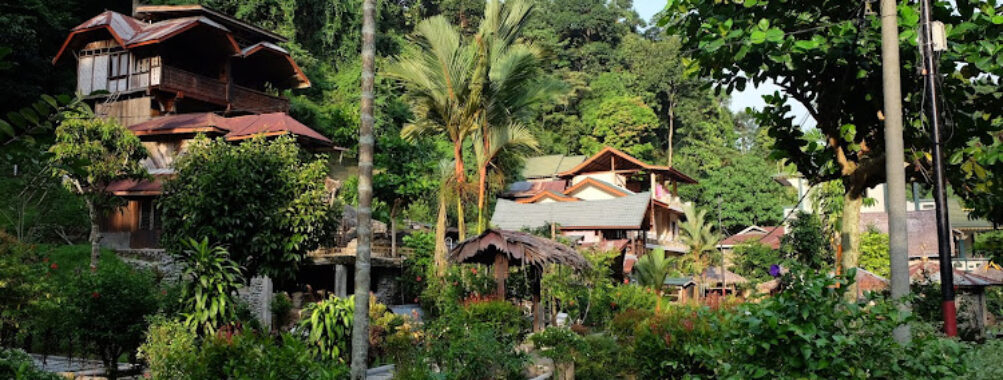
Bukit Lawang Ecotourism
Table of Contents
Bukit Lawang Ecotourism in Langkat Regency, North Sumatra, Indonesia, is one of those places that stays with travelers long after they’ve packed up their backpacks and washed the red Sumatra mud off their shoes. It sits beside the Bohorok River, right on the edge of Gunung Leuser National Park, a UNESCO-listed sanctuary known for its rich biodiversity and its key role in the survival of the critically endangered Sumatran orangutan. The small village of Bukit Lawang itself thrives around this ecotourism movement—simple, warm, and buzzing with life, yet never losing its laidback rhythm that visitors often say reminds them what slow travel is really about.
The heart of Bukit Lawang Ecotourism is more than just trekking—it’s about conservation, education, and finding a balance between human livelihood and wildlife protection. Behind every jungle trek or canoe ride is a story of the local community working hand in hand with conservation groups to protect their forest home. Visitors can observe semi-wild orangutans in their natural habitat, spot Thomas leaf monkeys dancing through the branches, or listen to the haunting calls of gibbons echoing through the rainforest. And honestly, few sounds beat that early morning jungle chorus.
This is not a polished, luxury destination. It’s a bit rough around the edges, which is part of its charm. Sometimes your shower might just be a bucket and you’ll have geckos watching you brush your teeth—but that’s all part of the authentic jungle experience. What truly makes Bukit Lawang Ecotourism stand out is the sense of purpose behind every activity here. You’re not simply visiting a tourist attraction; you’re engaging with an eco movement that helps safeguard one of the last remaining strongholds for wild Sumatran species.
Personally, one of my favorite memories here was a jungle night trek—when the fireflies blinked like stars among the trees and our guide pointed out tiny nocturnal frogs. It hit me how precious this ecosystem is and how easily it could vanish without responsible travel practices. Experiences like that change the way you think about ecotourism altogether.
Travelers generally find the best time to visit Bukit Lawang Ecotourism to be during the dry season, from May to September. Jungle treks are easier, rivers are calmer, and wildlife sightings—especially orangutans—tend to increase since food sources are more predictable. That said, I’ve been there during the rainy months too, and there’s a certain magic to it. The rainforest becomes this lush, breathing world of mist, dripping leaves, and deep greens, perfect if you don’t mind a bit of mud.
Peak months can get busy, especially with backpackers and international visitors drawn to Sumatra’s natural charm. Those seeking fewer crowds might prefer coming right before or after the high season. Just pack decent rain gear—because even outside the monsoon months, the jungle likes to remind you who’s in charge.
Getting to Bukit Lawang Ecotourism is relatively straightforward but requires some patience. Most travelers start from Medan, North Sumatra’s capital city. The drive to Bukit Lawang takes around four to five hours, depending on traffic and weather conditions. Private cars, shared minibuses, or local buses are available options. And yes, the final stretch includes a somewhat bumpy road—but that’s part of the adventure. I’d say, treat it as your first jungle test.
Once you arrive at Bukit Lawang, the village unfolds along the riverbanks. Vehicles stop before the pedestrian bridge, and from there, it’s a short walk across to the main village area—lined with small cafés, locally run lodges, and tour operators. You’ll often be greeted by smiling locals who offer help or simply say “selamat datang” (welcome). Most guesthouses can also arrange trustworthy transfers from Medan or even Berastagi, making logistics less of a headache.
It’s worth noting that Bukit Lawang isn’t wheelchair-accessible due to its terrain—steep paths, river crossings, and jungle trails can be challenging. For those traveling with children, though, it’s a great introduction to the wild. Many families take short, safe treks or visit local bat caves, combining fun with education about wildlife and conservation.
Before setting out on your Bukit Lawang adventure, a few insights can really help you make the most of your trip. I learned most of these by trial (and a few leech bites), but you don’t have to.
And here’s a little personal thought—don’t rush your stay. Spend an extra day just sitting along the Bohorok River, maybe sharing a cup of hot Sumatran coffee with your guide or watching kids play in the water. The simplicity, the laughter, and that wild backdrop will imprint more deeply than any itinerary might plan.
Bukit Lawang Ecotourism invites travelers to experience the rainforest in a sustainable way, to reconnect with what’s real, and to support a mission that keeps both nature and communities thriving. Whether you come for the trek, the orangutans, or just to escape the noise of city life, you’ll find something intangible here—a reminder that protecting wild places is both a responsibility and a joy.
Description
Key Features
Best Time to Visit
How to Get There
Tips for Visiting
Location
Places to Stay Near Bukit Lawang Ecotourism
Find and Book a Tour
Explore More Travel Guides
No reviews found! Be the first to review!